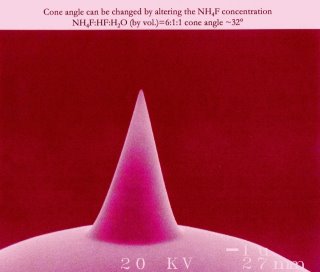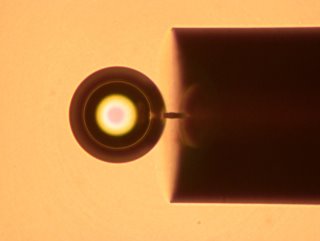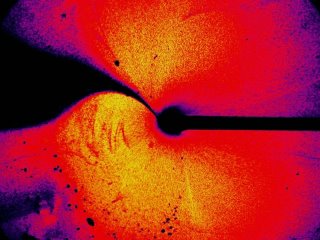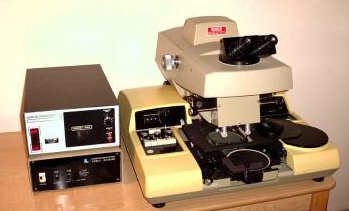Fiber Based Laser Tweezers & NSOM Probes
As a consequence, the metal clad glass tip will absorb a fair bit of light and in collection mode little of the light collected from the tip will actually enter into the dielectric core, resulting in little collected light from a Betzig style probe will make it to the far end of the optical fiber due to cladding losses

Fiber based laser tweezer gently gripping a mollusk ~0.4mm long
Most any Betzig style NSOM fiber probe used by most researchers in NSOM, will perform pretty miserably in optical collection mode, since the photons that enter the tip apex have a relatively low efficiency in making their way to the large enough diameter of the optical core that has not been distorted down to the tip diameter.
But there is a way to make 20nm sharp purely etched fiber probes, very consistently and with excellent collection efficiency.......
The same basic method of probe formation can also make a unique and superb optical fiber based laser tweezer, at much lower cost than a conventional far field focus spot laser tweezer...
PICTURES COURTESY OF ROD TAYLOR CNRC ( his works )
[click on pictures for larger views]

Sharp Tip Etched NSOM probe - note large optical core diameter at base of tip - critical for high optical collection efficiency in NSOM.

Fiber Laser Tweezer Trapped Bubble in Liquid

The helical vortice from laser tweezer liquid heating
POSTSCRIPT Feb 5th 2006
An unspoken area of application for high collection efficiency NSOM Probes is for optoelectronic circuit diagnostics of advanced MOS devices.
There is a fair bit of activity in high speed optoelectronic circuit diagnostics by imaging using microscopy and hot carrier photoemission for (sub?)ps timing analysis using conventional microscopy at Credence in Fremont and their purchased technology from a firm they bought called Optonics a few years back. Theirs is conventional microscope optics to a ?gated ?intensified cooled camera in ?IR
A fiber based method would possibly beat far field imaging hands down for RT circuit node data extraction BUT the issue will be since this is backside imaged ( requires substrate thinning on a BGA flip chip like P4/ Athlon 64 etc ) the backside thinning will likely limit the effective optical path length so that spatial localization is not optimal ( ie not truly near field, but likely to be far better than microscope lens collection to a camera ).
None the less, ps optical emission circuit diagnostics are astounding and this might be the first way to try to make an equivalent modest cost quasi nearfield "photonic oscilloscope probe" All this is conjecture on my part, but I would not be surprised based on prior efforts in mems based nanoscale circuit probing that we see an NSOM based photonic "oscilloscope" probe in the near future based on the excellent collection efficiencies available with this kind of low loss NSOM optical collection probe. I suspect someone is trying this RIGHT now....
Feb 14th 2006
Curious thought - can an effective combined NSOM, AFM and fiber based laser tweezers be implemented? Basically this comes down to whether sharp tip NSOM AFM can properly implement laser trapping with correct / optimal light wavelength and power, without appreciably degrading the other functions.
JOURNAL REFERENCES -
1) R.S. Taylor and C. Hnatovsky “Particle trapping in 3-D using a single fiber probe with an annular light distribution” Optics Express,11,2775-2782,2003.
2) R.S.Taylor and C. Hnatovsky “Trapping and mixing of particles in water using a microbubble attached to an NSOM fiber probe” Opt. Express 12, 916-928, 2004.
3) R.S. Taylor and C. Hnatovsky “Growth and decay dynamics of a stable microbubble produced at the end of a near-field scanning optical microscopy fiber probe” J. Appl. Phys.,95, 8444,2004.
4) P.Burgos,Z. Lu,A. Ianoul,C. Hnatovsky,M.-L. Viriot,L.J. Johnston and R.S. Taylor “Near-field scanning optical microscopy probes:a comparison of pulled and double-etched bent NSOM probes for fluorescence imaging of biological samples”,J. of Microscopy,211,Pt.1, 37-47,2003.
5) R.S. Taylor, K.E. Leopold, M. Wendman, G. Gurley and V. Elings, “Scanning Probe Optical Microscopy of Evanescent Fields”, Rev Sci. Inst., V69, Nr8 p2981
6) R.S. Taylor, K.E. Leopold, A. Delâge, M. Wendman, G. Gurley, V. Elings, "Near-field scanning optical microscopy", Physics in Canada 54 (2), 116-121 (1998).
7) R.S. Taylor, K.E. Leopold, M. Wendman, G. Gurley and V. Elings, "Bent-fiber near-field scanning optical microscopy probes for use with commercial atomic-force microscopes", Proc. SPIE V.3009, p. 119 (1997).
wendman nano nanotech near+field+microscopy near+field scanning+optical+microscope optical+microscope+Ohtsu Ohtsu+nsom Taylor+nsom Digital+Instruments+AFM Nanonics Lewis+nsom Betzig+nsom nanotechnology nsom nsom+microscopy









